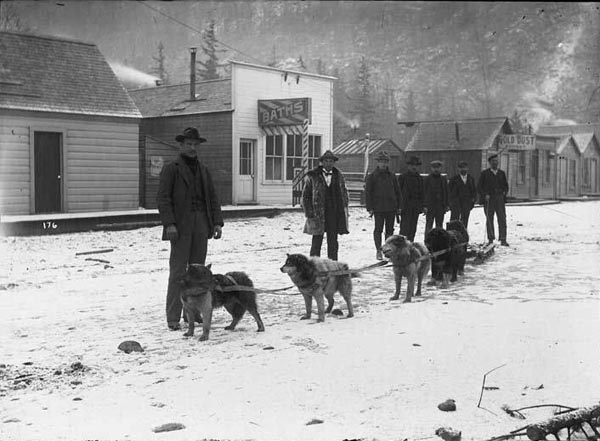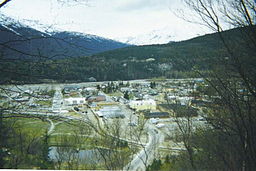

Klondike- Gold Rush to Present
The discovery of Gold in the Canadian Klondike in 1896 lured large number of people to Alaska. the populations doubled in size.The Klondike gold rush of 1898 brought thousands of people to Alaska.

With the onset of the Klondike Gold Rush in 1896, prospectors began to realize the need for hardy dog teams that could pull heavy freight. The Alaskan Malamute became the most prized dog. Not only could malamutes pull heavy loads, but they required very small quantities of food for their size.
1897 a post office, a church, and a newspaper were founded in Skagway, and its population rose to 10,000 due to the gold rush. In 1900, Skagway became the first incorporated city in Alaska.

The Klondike and Alaska gold rushes lured a number of writers and poets to Alaska. Jack London wrote about the savage, frozen-hearted north. In The Call of the Wild, published in 1903, London spent the winter of 1897-1898 on the upper Yukon River. Robert Service came to the Canadian Yukon a few years after Jack London. Service's poetry is well known throughout Alaska He left the Yukon in 1912.
 The 110 mile WP&YR Railroad was completed with the driving of the golden spike on July 29, 1900 in Carcross Yukon connecting the deep water port of Skagway Alaska to Whitehorse Yukon and beyond to northwest Canada and interior Alaska. Later after the Gold rush the railroad struggled. The military borrowed it during WWII to haul war supplies
The 110 mile WP&YR Railroad was completed with the driving of the golden spike on July 29, 1900 in Carcross Yukon connecting the deep water port of Skagway Alaska to Whitehorse Yukon and beyond to northwest Canada and interior Alaska. Later after the Gold rush the railroad struggled. The military borrowed it during WWII to haul war suppliesDuring 1900, 23% of Skagway's citizens were Euroamerican adult women
1920-22 – Skagway Women’s Club forms and establishes Skagway Library in 1921.
 A road that went from United States through Canada to Alaska had been talked about as early as 1930.
Congressional committees had recommended that a road should be built in 1935 and 1939, but it
was not until 1943 .the Alaska Highway required over 1,100 pieces of heavy equipement and took over 3,000 troops to help build it. It was completed in 1942 at a length of approximately 2,700 kilometres (1,700 mi). The highway was opened to the public in 1948 and called the Alcan highway. It was extremely beneficial during the WWII for moving equipment and troops. Today it is called the Alaska highway and it is driven year round by tourists and locals.
A road that went from United States through Canada to Alaska had been talked about as early as 1930.
Congressional committees had recommended that a road should be built in 1935 and 1939, but it
was not until 1943 .the Alaska Highway required over 1,100 pieces of heavy equipement and took over 3,000 troops to help build it. It was completed in 1942 at a length of approximately 2,700 kilometres (1,700 mi). The highway was opened to the public in 1948 and called the Alcan highway. It was extremely beneficial during the WWII for moving equipment and troops. Today it is called the Alaska highway and it is driven year round by tourists and locals. 1994, the Skagway city dock collapsed and sent a tidal wave across the bay; the dock was rebuilt within the year. This is the 16th busiest cruise destination in the world.
1994, the Skagway city dock collapsed and sent a tidal wave across the bay; the dock was rebuilt within the year. This is the 16th busiest cruise destination in the world.In 1994 I drove from Anchorage to Dawson city and gambled at Diamond tooth Gerty's as a young 20 year old!

1998 was the centennial of the gold rush, the Chilkoot Trail National Historic Site in British Columbia merged with the U.S. park to create the Klondike Gold Rush International Historical Park.

Skagway was formally a city and becomes a borough in 2007. The Municipality currently employs 14 lead staff and many support positions. Regular elections are held every 1st Tuesday in October.

The WP&YR Railroad suspended operations in 1982 when Yukon's mining industry collapsed due to low mineral prices. The railway was reopened in 1988 as a seasonal tourism operation and served 37,000 passengers. Today, the WP&YR is Alaska's most popular shore excursion carrying over 360,000 passengers during the 2010 May to September tourism season.
Cause and Effect of the Klondike area:
1. The Gold rush increased population and thus towns were built in the Yukon. It became one of the fastest growing populations, however, Alaska being known for boom bust economy after the gold was gone most of the people also left. Although most of the people left after the gold rush, there is still environmental impact and the water from the Yukon river is not safe for drinking due to the pollutants left.
2.The Yukon railway was built to help move ore from mines; which assisted with the population boom and enhance Alaska's economy. Later closed and now is used for tourism, and today tourism is one of the most lucrative economic industries in Alaska.
3.The Alaska highway was built to assist with the War and moving equipment, it in turn worked to connect Alaska with the rest of the united states. Now many tourists drive the Alaska highway.

No comments:
Post a Comment